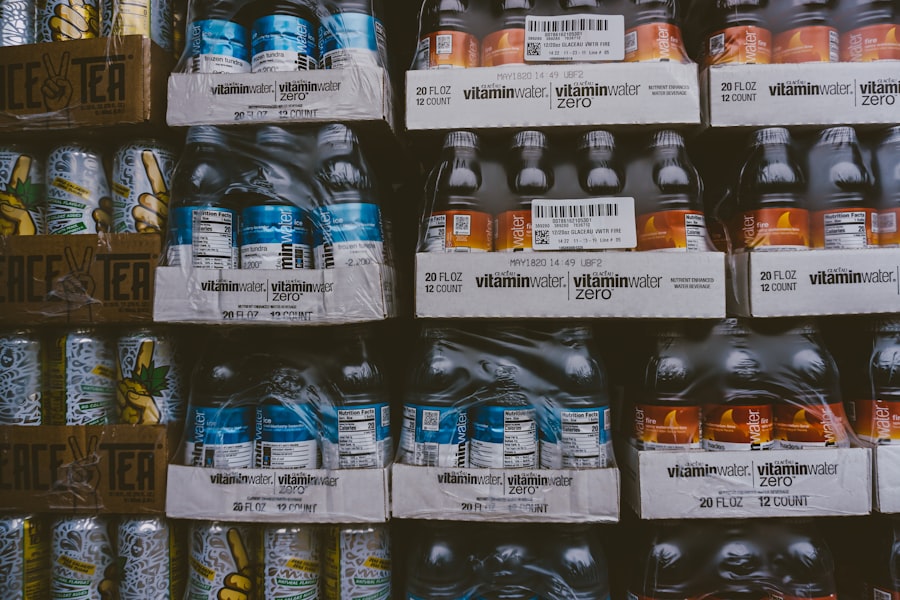
Serving size is a critical component of nutritional labeling that often goes overlooked by consumers. It is defined as the amount of food or drink that is typically consumed in one sitting, and it serves as a reference point for the nutritional information provided on the packaging. The serving size is usually expressed in common household measurements, such as cups, ounces, or pieces, which can help consumers gauge how much they are actually consuming.
However, it is essential to recognize that serving sizes can be misleading. For instance, a single serving of a snack food might be just a handful of chips, while the entire bag contains multiple servings. This discrepancy can lead to unintentional overconsumption, as individuals may not realize that they are eating several servings in one sitting.
Moreover, the concept of servings per container is equally important. This figure indicates how many servings are contained within the entire package. For example, a bottle of soda may list a serving size of 12 ounces but contain two servings per container.
If a consumer drinks the entire bottle without considering the servings, they may inadvertently consume double the calories, sugar, and other nutrients listed on the label. Understanding both serving size and servings per container is crucial for making informed dietary choices and managing caloric intake effectively. It empowers consumers to better align their food consumption with their nutritional goals, whether they are aiming to lose weight, maintain a healthy lifestyle, or simply make more informed choices about what they eat.
Interpreting the Nutritional Facts Panel
The Nutritional Facts Panel is a standardized format that provides essential information about the nutritional content of food products. It includes details such as calories, total fat, cholesterol, sodium, carbohydrates, dietary fiber, sugars, protein, and various vitamins and minerals. Each of these components plays a significant role in understanding the overall healthfulness of a food item.
For instance, monitoring sodium intake is crucial for individuals with hypertension or those looking to reduce their risk of heart disease. Similarly, understanding the amount of dietary fiber can help consumers make choices that promote digestive health and satiety. When interpreting the Nutritional Facts Panel, it is also important to consider the daily value percentages (%DV) listed next to each nutrient.
These percentages indicate how much a serving of the food contributes to a daily diet based on a 2,000-calorie daily intake. For example, if a product contains 20% DV of calcium, it means that one serving provides 20% of the recommended daily intake for calcium based on this caloric level. This information can help consumers assess whether a food item is high or low in specific nutrients.
A general rule of thumb is that 5% DV or less is considered low for a nutrient, while 20% DV or more is considered high. By understanding these values, consumers can make more informed decisions about which foods to include in their diets to meet their nutritional needs.
Identifying Hidden Sugars and Artificial Sweeteners

In recent years, there has been growing awareness about the health implications of excessive sugar consumption. However, many consumers may not realize that sugars can be hidden in various forms within processed foods. Ingredients such as high fructose corn syrup, cane sugar, agave nectar, and even fruit juice concentrate can contribute to the total sugar content without being immediately recognizable as “sugar.” This can be particularly deceptive in products marketed as “healthy” or “natural,” where hidden sugars may be present in significant amounts.
For instance, a seemingly nutritious granola bar may contain several types of sugar that collectively add up to a high sugar content per serving. Artificial sweeteners also pose a challenge for consumers trying to navigate their dietary choices. These synthetic sugar substitutes are often used in “diet” or “sugar-free” products to provide sweetness without the calories associated with sugar.
Common examples include aspartame, sucralose, and saccharin. While they may offer a lower-calorie alternative to sugar, there are ongoing debates about their long-term health effects. Some studies suggest potential links between artificial sweeteners and metabolic disorders or changes in gut microbiota.
Therefore, it is essential for consumers to read labels carefully and be aware of both hidden sugars and artificial sweeteners when making food choices. Understanding these components can help individuals make more informed decisions about their overall sugar intake and its impact on their health.
Recognizing Health Claims and Buzzwords
| Health Claim or Buzzword | Definition | Example |
|---|---|---|
| Organic | Refers to the way agricultural products are grown and processed | Organic fruits and vegetables are grown without the use of synthetic pesticides |
| Low-fat | Contains 3 grams or less of fat per serving | Low-fat yogurt |
| Gluten-free | Does not contain gluten, a mixture of proteins found in wheat and related grains | Gluten-free bread |
| Antioxidants | Substances that may protect your cells against free radicals | Foods rich in antioxidants include berries and dark chocolate |
Food packaging often features health claims and buzzwords designed to attract consumers’ attention and convey a sense of healthfulness. Terms like “organic,” “gluten-free,” “low-fat,” and “heart-healthy” can create an impression that a product is inherently better for one’s health. However, it is crucial to approach these claims with a critical eye.
For example, a product labeled as “low-fat” may still contain high levels of sugar or sodium, negating any potential health benefits associated with reduced fat content. Similarly, “gluten-free” does not automatically mean that a product is healthy; many gluten-free products are highly processed and may lack essential nutrients. Additionally, some buzzwords may not have standardized definitions or regulatory oversight.
For instance, the term “natural” is often used liberally in marketing but lacks a clear legal definition in many jurisdictions. This ambiguity can lead consumers to believe they are making healthier choices when they may not be. To navigate this landscape effectively, consumers should educate themselves about what these claims mean and consider the overall nutritional profile of the product rather than relying solely on marketing language.
By doing so, they can make more informed decisions that align with their health goals.
Analyzing Ingredient Lists
The ingredient list on food packaging provides valuable insight into what goes into a product. Ingredients are typically listed in descending order by weight, meaning that the first few ingredients make up the majority of the product’s content. This information can be particularly useful for consumers looking to avoid certain ingredients or allergens.
For example, if someone is trying to limit their intake of processed foods, they might look for products with shorter ingredient lists that feature whole foods rather than additives and preservatives. Moreover, analyzing ingredient lists can reveal potential allergens or undesirable components that may not be immediately apparent from the front label. For instance, many processed foods contain additives like artificial colors or flavors that some consumers prefer to avoid due to health concerns or personal preferences.
Additionally, recognizing specific terms such as “hydrogenated oils” can alert consumers to unhealthy trans fats that may be present in certain products. By taking the time to read and understand ingredient lists, individuals can make more informed choices about what they consume and better align their diets with their health objectives.
Differentiating Between Natural and Artificial Flavors

Flavoring agents play a significant role in enhancing the taste of processed foods; however, distinguishing between natural and artificial flavors can be challenging for consumers. Natural flavors are derived from plant or animal sources and are intended to mimic the taste of specific foods without adding significant calories or sugars. On the other hand, artificial flavors are synthesized chemically and do not originate from natural sources.
While both types serve similar purposes in food production, there are differences in how they are perceived by consumers. The term “natural flavor” can be somewhat misleading because it does not necessarily imply that the flavoring agent is healthier or more nutritious than its artificial counterpart. In fact, natural flavors can still contain additives or preservatives that some consumers may wish to avoid.
Furthermore, both natural and artificial flavors can trigger allergic reactions in sensitive individuals; thus, it is essential for consumers to be aware of what they are consuming regardless of whether the flavoring is natural or artificial. Understanding these distinctions allows individuals to make more informed choices about their food selections based on their dietary preferences and health considerations.
Deciphering Organic and Non-GMO Labels
Organic and non-GMO labels have gained popularity among consumers seeking healthier food options free from synthetic pesticides and genetically modified organisms (GMOs). Organic certification requires that products meet specific standards set by regulatory bodies; for instance, organic produce must be grown without synthetic fertilizers or pesticides and must adhere to strict guidelines regarding soil quality and crop rotation practices. This certification provides assurance to consumers that they are purchasing products produced through environmentally sustainable methods.
Non-GMO labels indicate that a product does not contain genetically modified ingredients; however, it is important to note that non-GMO does not necessarily equate to organic. A non-GMO product may still be heavily processed or contain additives that some consumers prefer to avoid. Additionally, while organic products are generally considered healthier options due to their production methods, they can also come with higher price tags compared to conventional counterparts.
Therefore, consumers should weigh their priorities—whether they prioritize organic certification for environmental reasons or non-GMO status for personal beliefs—when making purchasing decisions.
Navigating Allergen Warnings and Dietary Restrictions
Allergen warnings on food packaging serve as critical information for individuals with food allergies or intolerances. Common allergens such as peanuts, tree nuts, dairy, eggs, soy, wheat, fish, and shellfish must be clearly labeled according to regulatory guidelines in many countries. These warnings help protect vulnerable populations from potentially life-threatening reactions caused by accidental exposure to allergens.
However, it is essential for consumers to recognize that cross-contamination can occur during manufacturing processes even if a product does not explicitly list an allergen in its ingredients. In addition to allergen warnings, many products now cater to specific dietary restrictions such as veganism or gluten intolerance by providing clear labeling regarding their suitability for these diets. For example, vegan products will typically indicate that they do not contain any animal-derived ingredients while gluten-free products will specify that they have been tested for gluten content below certain thresholds.
Understanding these labels allows individuals with dietary restrictions to navigate grocery store aisles more confidently and make choices that align with their health needs and lifestyle preferences. By paying attention to allergen warnings and dietary labels, consumers can better protect themselves while enjoying a diverse range of food options.
FAQs
What is the purpose of reading food labels?
Reading food labels helps consumers make informed decisions about the foods they eat by providing information about the nutritional content, ingredients, and potential allergens in the product.
What information can be found on a food label?
Food labels typically include serving size, calories, macronutrients (such as fat, carbohydrates, and protein), vitamins, minerals, ingredients, and allergen information.
How can I read food labels the smart way?
To read food labels smartly, pay attention to the serving size, check the calories and nutrients per serving, look for added sugars and unhealthy fats, and be aware of common allergens.
Why is it important to pay attention to serving sizes on food labels?
Understanding serving sizes is crucial for accurately assessing the nutritional content of a product and for managing portion control to maintain a healthy diet.
What are some common misconceptions about food labels?
Common misconceptions about food labels include assuming that “low-fat” means healthy, overlooking added sugars, and not paying attention to serving sizes.





